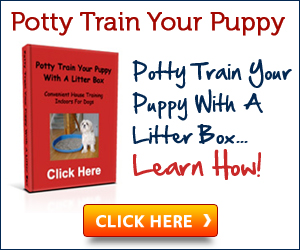Puppy House Training It’s Easier Than You Think
House training is something that is vital if you want to have a good experience of being a dog owner. It is a training that should stay with your dog for his whole life so it’s worth getting it right from the start. A lot of people think that this is a difficult task, that it will take months of work, but in reality it is one of the simplest things to achieve. It took me just four days to house train my puppy, to give him a command for going to the toilet that he always responds to, and with the following methods, you can be just as successful. It may take a few weeks, depending on you, your attitude, your living arrangements and many other factors, but with patience and lots of time and effort, you can have a perfectly house-trained dog for life.
This method does not entail using a crate, just regularly keep your dog in one particular area of the house, especially when unsupervised. It’s best if it’s an easily cleaned floor, such as a linoleum in the bathroom, as there will be a few accidents to start with. You cannot allow your puppy to wander around the whole house unsupervised as she will just go to the toilet whenever she feels like it without being trained to do otherwise. Make sure your puppy has a nice comfortable bed in her chosen area and that she is happy to use it. Once she establishes the bed as her own, she is less likely to mess near it. You should also ensure that she is happy in this area – fresh water should always be available, and play with her and pet her there so she feels happy, safe and secure.
The key to this method of house training is observing your puppy’s behaviour, so you must spend lots of time with her. The other important factor is to have a regular routine for feeding. Puppies usually need to go to the toilet after eating, so a routine will help you both. Check also that her food and water and the quantities are suiting her digestive system. You can’t house train a dog who has diarrhoea, so this must be sorted out right at the beginning. Speak to your vet if you can’t resolve this yourself or if there are urinary problems – it could be an infection.
So here’s the procedure, once you have everything in place. Think of a command word that you will use every time you see your puppy about to go to the toilet or when you want to encourage her to do so. When she wakes in the morning, within half an hour after eating and before she goes to sleep, you should take her to her toilet area (this will either be some newspaper on the floor or a convenient area just outside the back door in the garden) and give her the command. The likelihood is that, if you are patient enough, she will go to the toilet and you can praise her for doing so in the right place. When a puppy is young, they have little control and a small capacity for urine and faeces in their system, so you should take her out every two hours so she has the opportunity to go if she wants to.
When you are spending time with your puppy (and you should spend a lot time with her at this point in her life) you must observe her and become familiar with her behaviour when she’s about to go to the toilet – mine looks agitated and walks around with his knees slightly bent just before he goes, sniffing the ground in circles. Once you know this, you can pre-empt your own puppy’s need, and either pick her up or call her quickly to her toilet area. Once your puppy is in the toilet area, give your toilet command in a friendly encouraging tone. If she walks away from the toilet area, lead her gently back there and give the command. If your puppy is really averse to going in that area, look for a reason why – there could be a good reason that needs addressing.
When your dog successfully goes to the toilet in the correct area, praise her and maybe give her a favourite treat. Each and every time she does as you’ve asked, in the toilet area, praise her enthusiastically. This is positive reinforcement and is the most important aspect of this training method. Soon, your puppy will look at you or whine when she wants to go to the toilet. You must be there, ready to respond quickly otherwise she will have an accident. If you are using newspaper in the house, this can be gradually moved outdoors, so that she understands that that is the new toilet area.
DO NOT chastise your dog when she gets it wrong. She will not understand why you’re telling her off and it will only confuse her. You should also be careful to clean up any accidents with a detergent that removes the smell – dogs like to mess again where they have left their scent and you need to discourage this through thorough cleaning practices.
So, to re-cap, spend lots of time with your puppy, learn her pre-toilet behaviour and pre-empt it. Lead her to her toilet area and give the toilet command. Praise her abundantly when she goes on command in the right place. Keep her living area clean, comfortable and fun to be in for both of you. Above all, be patient – house training does take time and your dog has a lot to learn at this stage of her life. She need lots of love, lots of fun and games and lots of encouragement.





